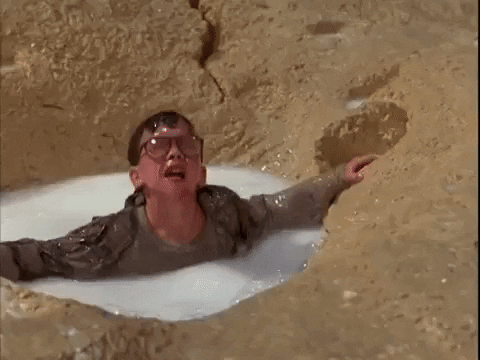This week I reviewed previous lessons I had learned last week. This included practicing notes E, F, & G and combining them with and without the use of 4 count rests. I feel that my fingering of each of these notes is relatively decent, but I’m still struggling with how to be comfortable with my articulation and breathing. It’s amazing how a couple of days off in between sessions sets you back and makes me feel like I’m stuck in a rut.
 Credit: Giphy
Credit: Giphy
To get another explanation of how articulation works, I found a YouTube video series created by Sean Osborn. He has created a set of 10 short videos to help beginners become familiar with the playing clarinet. I watched both the video on breathing and articulation and learned some new things that I didn’t learn from my Udemy course. One of these new learnings was understanding that one should use “the minimum amount of tongue, moving the minimum amount of distance, touching the minimum amount of reed.” To demonstrate this more, he was able to use a medical camera to get a video of the inside of this mouth to demonstrate his incredible ability to articulate (tongue) while playing. Check it out (start watching at 3:40 into the video clip below)!
Apparently while trying to achieve proper articulation, there is something called “anchor tongue”. This means you tongue the reed with the middle of your tongue instead of the tip and then rest the remainder of your tongue on the back of your teeth. I don’t know if I have this problem, but I would love a medical camera to assess the situation for me if anyone is willing to lend me theirs.
Back to my Udemy.com course. After I reviewed some lessons, I moved on to learning intervals, also known as scale in thirds (according to my Udemy.com course instructor). I was taught how to transition from the lowest note (C), skip a note (D) and play (E), go back to (D), skip a note (F) and play (G), and so on. This was more difficult for me as I tried to read the sheet music provided as a reference. I have not spent enough time becoming familiar with sheet music to be able to play six different notes on it in a musical fashion. However, I was given some sound advice in our last class discussion about our projects from my dear friend Brad Raes, for which he suggested that I don’t spend too much time learning how to read music. Because he’s a smart guy, this week I decided to simply watch my instructor as she placed her fingers on the instrument instead and mimicked her actions. Going back and repeatedly practicing allowed me to memorize the fingering as well as the sounds as I put them into practice. I know this isn’t proper, but I much preferred it. Rather than learning to read music, I may have to spend some time translating the notes to letters to make it easier for me to read and follow. Does anyone know if there are tablatures for clarinet like there are for guitar?
Here is a recording of my attempt at doing intervals solo, without the use of a metrinome or my online Udemy.com instructor. You can tell that I still struggle with keeping a good breathe as I advance from note to note, especially at the end.
I tried moving on to Section Four – Slurring, but didn’t get very far. This section introduces three new notes (B, A, and G), which required me to use my right hand. I’m not sure I’m ready for this as I feel I still need more practice with the first six notes that I’ve been practicing using my left hand. I may have to look for other resources to help get me more practice, such as the “Measures of Success” book that my daughter uses in school or other YouTube tutorials. Does anyone know of any other options I could explore? Udemy.com is moving much too quickly for me.

I know you are expressing some of your frustrations in your post this week however, I think it is sounding like you are making improvements even if it is not as quickly as you’d like. It seems like you are using some other resources to supplement the Udemy lessons. For me, one of the downsides to online learning (in some scenarios) is not having an instructor present to help you through the struggles or to ask questions and receive immediate feedback.
I have never played any wind instruments so I hadn’t given much thought to the breathing element which seems really tricky! It looks like you are working through the challenges though which is all part of the learning process. Good luck with your practice this coming week!
LikeLike
I agree with you with regards to not having an instructor present to help me through my struggles. Don’t get me wrong, the Udemy.com course is easy to follow, but I’m not ignorant to the fact that there is only 5 hours of instruction that starts very simple and gets very complicated in a short period. Although I was drawn to the short timeline, it’s not as thorough as I need. I feel that some more lessons and practice on most skills would be beneficial, but this is at the cost of extending the course timeline.
My 14-year-old niece is coming over this weekend to help me with a few things. So hopefully, she can fill the gaps, correct my mistakes, and get me back on track to continue on with my Udemy.com course.
LikeLiked by 1 person
Thanks for sharing your frustrations. Does Udemy control the pace of your learning? If there anything stopping your from repeating lessons and investing more time on a certain lesson? The pace of learning is always a difficult factor to address in the context of schools, as we teach in specific slices of time. Although progress is often desired, enforcing skills is to me, just as important and dedicating time towards it is never lost. How does Udemy account for the time factor?
LikeLike
I can definitely control the pace of my lessons and have repeated several of them based on my struggles. But like Brooke has mentioned, having some feedback on my struggles would be helpful when I keep making the same mistakes without knowing how to correct them.
The Udemy.com course fits a lot of material within a short amount of time. The short timeline is what drew me in, but I’m realizing that it may not be as beneficial as I thought. No matter what, I’ll keep plugging along and continue to search out other resources to supplement this course
LikeLike
Pingback: The Piano Project: Week 3- Technology Trials